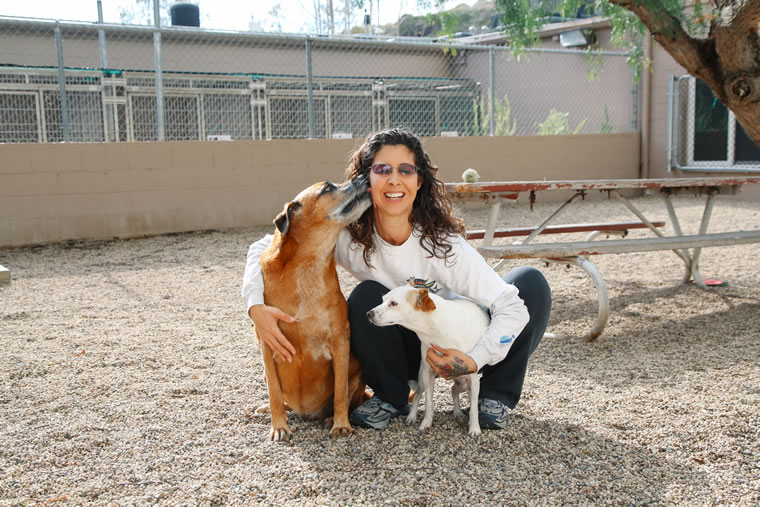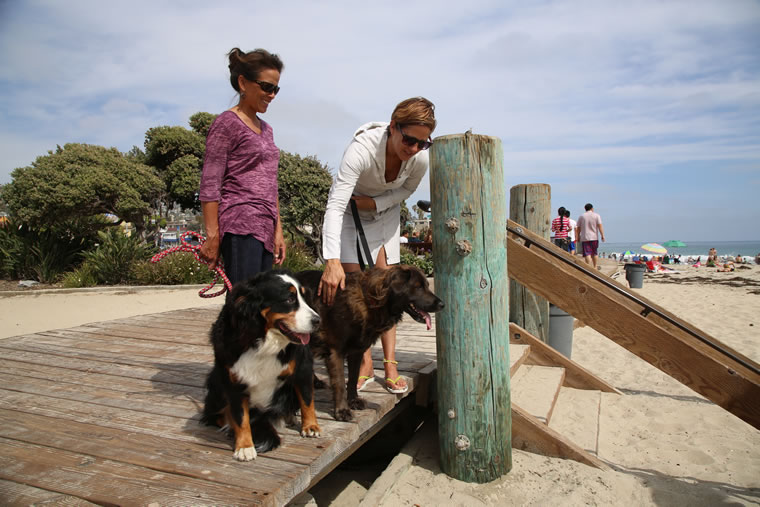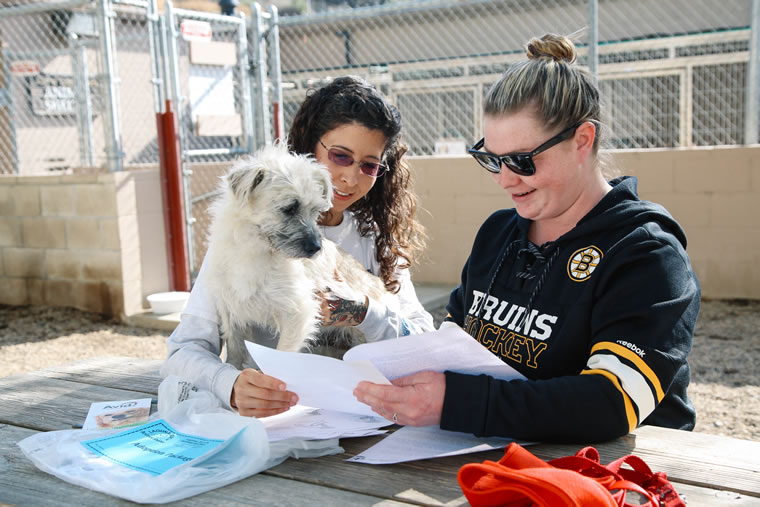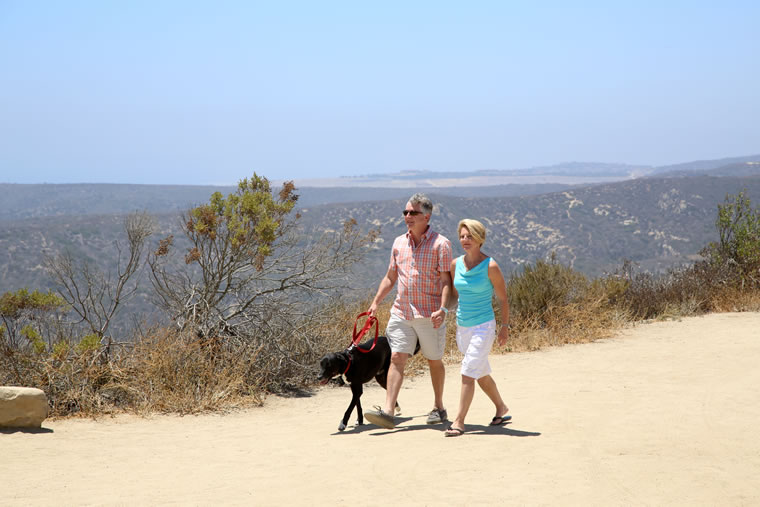
Valentine’s Day is just around the corner, and romance is in Laguna’s sea-scented air. With miles of beach for strolling, numerous parks for playing and delicious restaurants for dining, the city is a perfect backdrop for new relationships to unfold. But instead of romantic love, consider enjoying the love—and accompanying wet kisses—of a dog by adopting. A meaningful relationship can be found by driving up the canyon to Laguna Beach Animal Shelter, or visiting another area shelter or rescue group, where canines are waiting for a caring human companion and permanent home.
As anyone who has ever experienced the love of a pet will know, you’ll get much more than you give. By providing a home to a dog in need, you will help alleviate the larger problem of animal overpopulation while gaining a partner who will love you unconditionally. And isn’t that a perfect Valentine’s Day gift to both give and receive?
“I think anyone who has adopted a dog … can feel the appreciation,” says Ann Marie McKay, board president of Protecting Unwanted Pets, or PUP Laguna Beach, the volunteer and fundraising arm of the Laguna Beach Animal Shelter. “You see almost a different personality in these animals, many of which may have experienced a harder life. When they are in your home and they have been rescued, there is just that sense of appreciation from them.”
Be My Valentine

While a random strike of Cupid’s arrow could cause you to fall in love at first sight, when it comes to choosing your companion, it is important to do some homework to live happily-ever-after. Learning about the personalities of different breeds of dogs and breed mixes commonly found at shelters and rescues will help ensure success when adopting. Understanding your own lifestyle and what it is you want in a dog is equally important.
“A lot of people don’t educate themselves in terms of breed temperament and characteristics,” says Vickie Marx, dog trainer and director of The West Coast Academy of Dog Training. “There are breeds that are better with children than others. There are breeds that are better for joggers and more active people, and others better for people who are more sedentary. If you are not an active person, don’t get the dog that is bouncing off the walls. Many times I have seen people get a dog and then complain about its activity level. That is because they didn’t educate themselves first.”
“People really need to think about the basics and the things that are challenging for a dog because not all good dogs fit into all good homes,” says Penny Milne, animal behavior consultant with DubDubDog Animal Behavior Services.
Think about your lifestyle and personality, Penny advises. Do you have children? How many hours do you work? How much exercise will you actually give a dog? Are you an affectionate person, or more hands-off?
“People really need to think about the basics and the things that are challenging for a dog because not all good dogs fit into all good homes.” – Penny Milne, animal behavior consultant
“Some very nice, affectionate dogs are not cuddly dogs,” she says. “They’ll hang out next to you and are devoted to you but don’t want you to hug them. And it goes the other way around. There are the dogs that don’t want to stop touching you. It’s like ‘I love you honey, but I need that hand to type with.’ So think in terms of what you are like, what your life is like, what your home environment is like and what you really need in a dog. And what is easy and what is challenging for a dog about your household.
“Sometimes people just want the falling in love experience,” she continues. “They are like, ‘I am going to go [into the shelter], and I’m going to see those eyes and that curly fur, and he is going to look at me, and we’re going to be the only two creatures on the planet, and then I’ll take him home.’
“It may seem a little bit more clinical to say, ‘Here are the four or five things that are really important to me, and the rest of the stuff is not that important.’ ”
Another thing to consider may be age. An older dog may already be house-trained and have fewer training issues than a younger dog or puppy.
“Sometimes older dogs coming from shelters may have behavior problems, but in general they are just easier,” Vickie says. “They have gone through all the chewing and things, and it makes for an easier transition.”
Also, think about where you live. While property size and yard space are considerations, the dog’s breed or size might also be an issue. The city of Laguna doesn’t have breed or size restrictions, but if you rent, your rental apartment or house might, so it is important to check your agreement. And certain Laguna housing locations could affect dog behavior. As an example, Penny says, if you live in a location like Arch Beach Heights with rows of streets laid out on the hillside and houses looking down at houses below, or if you live on a street that has a constant parade of traffic heading to the beach, that “constant fodder” in front of the dog may cause barking issues. While it may be difficult to tell at the shelter if a dog is a barker, it is something to keep in mind and ask shelter personnel about.
Both Vickie and Penny strongly advise letting shelter staff help guide adoption decisions. “They have been around these dogs awhile and are more familiar with their personalities,” Vickie says.
The Adoption Process

Volunteers and staff at Laguna Beach Animal Shelter try to ensure compatibility between adopters and adoptees, and that process starts with an application that asks questions about your lifestyle, home environment, reasons for adopting and more. There is also a $100 adoption fee for dogs. One example of something the shelter will ask about is whether you have a secure, fenced yard at home. If you live in an apartment with no outdoor yard and want a large dog, this would probably get you disqualified for that particular pet, but not from adopting overall. The shelter also sometimes does background checks. For adopters from Laguna or Laguna Woods who say they have previously had dogs, the shelter might check with the city to make sure the person acted responsibly by licensing their dog.
If you currently have another dog or dogs, the shelter will ask you to bring them there to meet the prospective four-legged family member. The shelter has a play yard where the new siblings can get to know each other to help ensure harmonious relationships. All human members of the household must also come to the shelter to meet the potential new addition.
Once you have applied, there is a waiting period while the adoption committee reviews the application. This can vary depending on the animal.
“If the dog has been medically cleared, it may be less than a week,” Ann Marie says. “If the animal has a condition to clear up, it could be a week or it could be a month, depending on the issue. The Laguna Beach shelter only adopts out animals that are medically ready rather than leaving the issue to the new adopter to worry about.”
All dogs are vaccinated, bathed and groomed, spayed or neutered, dewormed, microchipped and checked out by a veterinarian for health concerns before being put up for adoption. If you adopt from another shelter or from a rescue group, the adoption process and criteria will vary. Vickie notes that if you are working with a shelter that does not provide health checks, you should immediately take the animal you have adopted to a veterinarian.
Once the day comes to take your new companion home from the Laguna Beach Animal Shelter, a representative will sit down with you and provide information about the dog’s specific needs and answer any questions. They will also offer information about pet supply stores, dog trainers and other local resources. The shelter provides about a week’s worth of the current food the dog is being fed so that you will have time to transition the dog to whatever food you are planning to give. Before bringing your new companion home, be sure you have picked up the necessary high-quality food, bedding, chew toys and other supplies and prepared your home and schedule for his arrival. And when picking up your dog, don’t forget a leash, Ann Marie reminds.
Becoming a Family

Ann Marie advises adopters to give their dogs time to get acclimated to their new environments.
“My first word of advice would be to be patient and give it time,” she says. “Sometimes when you first bring home an animal, and especially from a shelter, there is going to be a transition period for that animal to get used to you and your home. And they might act in a way that you don’t find appropriate initially, but given time that animal will eventually get comfortable with its surroundings and what the rules are of the house. It is important not to give up the first week. Give it time and love.”
And while lots of love is called for, it is also important to give the new family member some space because even though they are going to a “forever home,” the transition can be stressful to them. Vickie cautions against overdoing picking the dog up in those first days, which a lot of children will tend to do. Also, coming from a shelter, they may have separation anxiety and need to learn to be left alone. “Keep them busy chewing on a Kong toy or Nylabone,” she says.
“The first thing a lot of dogs need is just a carefully managed environment, so it is physically and socially safe,” Penny says. “Set the dog up with a simple schedule of regular meals with quiet playtime and quiet downtime. Instill a quiet and predictable pattern.”
And if things aren’t going as smoothly as you would like, there is an appropriate time for calling in professional help.
“If you see any aggression, you should call somebody right away,” Vickie says. “Destruction and house-training are also easier to get under control before it becomes a habit, so if you want to make it an easier transition, call somebody right away, especially with a younger dog.”
Once your new family member is settled into your home, you can enjoy dog-friendly Laguna together in a variety of ways. Numerous restaurants in town allow dogs on their patios, and some even provide water bowls and treats. Most parks allow leashed dogs, except for Bluebird Park, where dogs are not allowed; Boat Canyon Park does not allow dogs from June 15 to Sept. 15. Leashed dogs are allowed on the beaches except between June 15 and Sept. 10 from 9 a.m. to 6 p.m.
While there are plenty of great spots for bonding with your new valentine, the experts have a few favorites for spending time with their canine companions. “We love to walk all over,” Penny says. “Laguna is such a dog friendly and walkable town.”
“One of the most beautiful walks is down by the Montage or Main Beach,” Vickie says. “We also like Top of the World. There is a nice trail up there, but look out for rattlesnakes during summer. One of the things I like about Laguna is that there are a lot of dog-friendly restaurants, such as Zinc Cafe, Madison Square, Active Culture and others.”
And Ann Marie, who lives in North Laguna, enjoys taking her two dogs, Angie and Andy, both adopted from the shelter, to Heisler Park. “I enjoy going there,” she says. “I am able to give them a good walk and plenty of exercise.”
—By Vicki Hogue-Davies | Photos by Jody Tiongco




